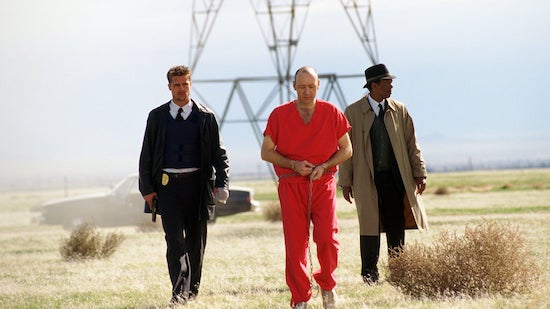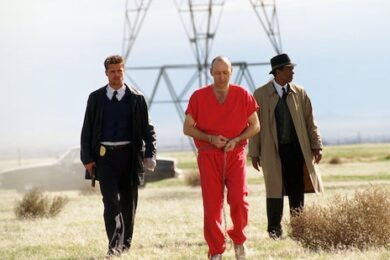The gruesome, grim and gut-wrenching ending of Se7en is unparalleled. The “What’s in the box?” scene is a murderous masterpiece; Fincher’s direction is so violent, visceral and unsettling that the scene becomes not only about an execution on film, but the execution of film-making.
All of the elements in this scene combine to create the final climax in which detective David Mills (Brad Pitt) shoots serial-killer John Doe (Kevin Spacey): the sickly yellow colour palette; the handheld camera shots; the ominous crescendo in the score; and the menacing metaphor of Doe’s silhouette in his blood-red uniform against the setting sun.
In killing him, Mills fulfils Doe’s prophecy; in Doe’s own words, he “[becomes] vengeance, [becomes] wrath.”
Twenty-five years ago, when audiences first walked out of the cinema solemn and more than a little shell-shocked, critics realised the seismic power of the film.
Roger Ebert said that “Se7en is one of the darkest and most merciless films ever made in the Hollywood mainstream,” whilst John Wrathall described it
as “the most complex and disturbing entry in the serial killer genre since Manhunter.”
These reviews still ring true; the film’s themes are intense, insidious, and irredeemably gloomy, and yet the performances and psychological terror of the script are still undeniably gripping. Its box-office success (it was the seventh-highest grossing film of 1995) arguably secured Fincher’s image as a master of bleak, bold blockbusters, and it is still the 28th most highly rated film of all time on IMDb.
There are many works that had an important influence on the film: Silence of the Lambs, Psycho and M, to name a few. However, one of the most revelatory influences, and one that can help us to understand the fatal foreshadowing of the characters’ endings, is actually a genre that came 500 years before Se7en: the medieval morality play.
Morality plays were popular dramas in 15th and 16th century Europe, and followed a relatively formulaic format. The plays were allegorical, and would involve a single protagonist (representing humanity as a whole) persuaded by characters (personifications of various moral attributes) to choose a good life over one of evil.
For example, in Everyman (c.1510), the protagonist Everyman is visited by Death, Good-Deeds, Angel, Knowledge, Beauty, Discretion and Strength, and is eventually convinced to give up his focus on material possessions and submit to the ultimate power of God. In many respects, David Mills is our Everyman – he is the relatable, likeable, idealistic hero who is admirable, but also deeply flawed.
John Doe, on the other hand, is the Vice figure: the embodiment of evil who dangerously attempts to control Man’s soul – or, in the case of Se7en, exploit his biggest weakness: wrath. Doe is a symbol of temptation, and ultimately tempts Mills into indulging his most lethal shortcoming: his temper.
Fincher feeds the viewer clues throughout the film that Mills is volatile and quick to anger: he furiously ejects a photographer (who we later find out is John Doe) from one of the crime scenes; he throws a violent tantrum when he finds out how close John Doe has been to him all along; and he angrily storms into the apartment even when Detective Somerset (Morgan Freeman) argues that they cannot enter without reasonable intent.
However, screenwriter Andrew Kevin Walker’s decision to name our Vice figure John Doe is a very telling one. The title is normally employed when the true name of a person is unknown or intentionally concealed, and so gives our villain a degree of anonymity.
Nonetheless, Kevin Spacey’s character could have revealed his true identity at the end, and this disclosure would have been in keeping with the egotism of his character; he boasts that his crimes are “setting an example” which will be “puzzled over and studied and followed forever.” John Doe may see himself as a kind of messiah, but his name does not give him any sort of status – it does quite the opposite.
By giving him such a generic moniker, Walker is effectively making him a symbol much in the same way that characters in morality plays were. Just as Everyman represented every man, the name John Doe also stands for mankind; his character therefore is both anyone and everyone.
Indeed, in this depraved, hellish metropolis, the average man is more associated with the villain than the hero; as John Doe says himself: “Only in a world this shitty could you even try and say these were innocent people and keep a straight face.”
The function of Everyman therefore was to show the temptation for evil that lies within all of us, and this is what John Does too. His crimes are visual reminders of our everyday sins, whilst his own self-proclaimed sin – envy – is what ultimately drives Mills to murder. There is an argument that by killing Doe, Mills lowers himself to Doe’s level; our Everyman becomes Vice, whilst our Vice becomes Everyman.
Detective Somerset is the only one who manages to avoid the fall into temptation. His cynicism is evident from the opening scene, but also his compassion; when investigating the first crime-scene his immediate question is “Did the kid see it?”, whilst the other officer only asks “What kind of question is that?”
Somerset is clearly jaded, burdened by the state of the world and his loss of faith in humanity; he agrees with Hemingway that the world is worth “fighting for”, but knows that does not necessarily make it a “fine place.”
Somerset, then, feels akin to the Justice figure in morality plays. In their essay “Justice and Equity in the English Morality Play”, McCutchan and Wilson described the Justice figure as a character “concerned with the divine pronouncement of judgement on man.” It was only in the late 1500s that the Justice character evolved into more of a civil figure than a theological one, concerned with the criminal rather than the cosmological.
Somerset is preoccupied with both. He wants to bring John Doe to justice, but remains acutely aware of the wider moral implications at stake; he desperately warns Mills, “If you kill him, he will win.” As Mills continues to shoot at Doe, Fincher deliberately gives us a close up of Somerset, whose reaction is a painful mix of resignation and despair. His expressions confirm what we already know: that despite their best efforts, neither legal, moral nor theological justice has been served.
Se7en is endlessly symbolic. It is no coincidence that Doe lives in apartment 5A or that Mills shoots Doe six times: envy is the fifth Deadly Sin, whilst wrath is the sixth. The number seven is traditionally a symbol of perfect order, or a complete cycle – and, indeed, Doe is aiming to establish a new order through this social purge.
His twisted goal of purification is mirrored through constant rainfall, biblically associated with cleansing or ablution; the story of Noah and the flood is narrated in Genesis 7, when God says, “For after seven more days, I will send rain on the earth.” Foreshadowing in Se7en is so extensive it borders on predetermination – there is a constant sense that larger forces are at work than just Doe himself.
The murders also have a quasi-religious significance. Each crime scene evokes a kind of voyeuristic fetishism; they are so carefully calculated and constructed that they almost feel like perverse art installations, or bloody paintings. Much like religious iconography, the murders are supposedly meant to warn man of the wrath of God.
However, they are really warning us of the wrath of John Doe, so again, the wrath of Everyman, and thus the wrath of David Mills. Each murder allows not a step towards the hero finding the villain, but the villain finding the hero.
Morality plays also aimed to shock their medieval audiences with wicked spectacles: devils, evil angels and dancing demons would appear on stage in an attempt to scare straight highly superstitious audiences. Christopher Marlowe’s Doctor Faustus also includes a pageant of Seven Deadly Sins, where a personification of each sin appears on stage, giving a brief speech in which they describe their evil origins.
The key difference between Se7en and a morality play is that in the latter, good always triumphs over evil. Doctor Faustus caused great controversy when it was first performed in 1592; many argued that Marlowe’s depiction of a man selling his soul to the devil was proof of his atheism, and that the play glorified man’s hubris. Yet even Doctor Faustus has a conservative ending: Faustus is dragged to hell by demons, and the cosmological order is once again restored.
In Se7en, there is no such resolution. John Doe is not a messenger of the devil nor a mouthpiece for God – he is a representation of Everyman, of humanity. And that is most terrifying of all.



